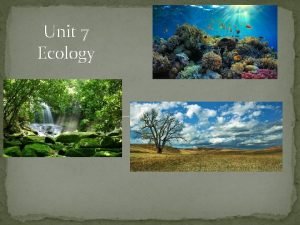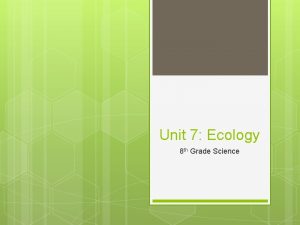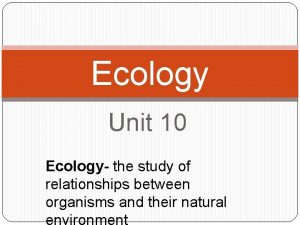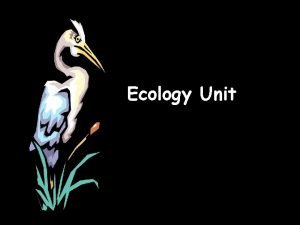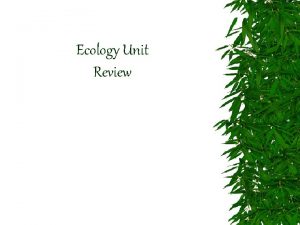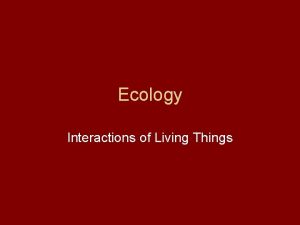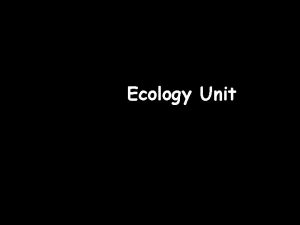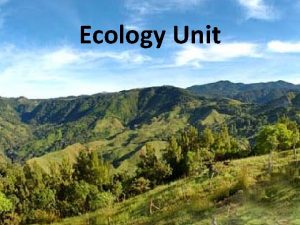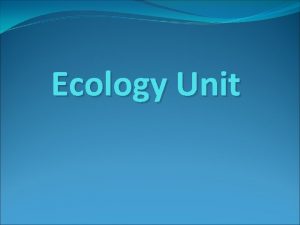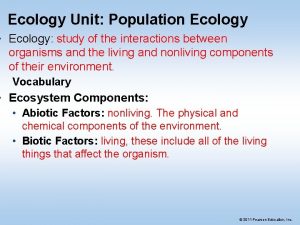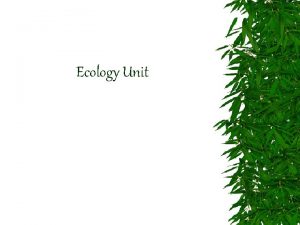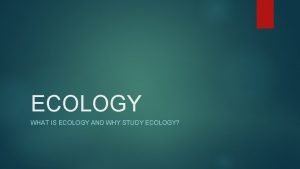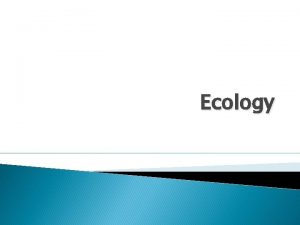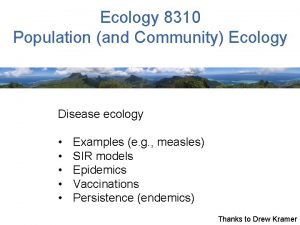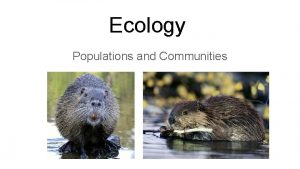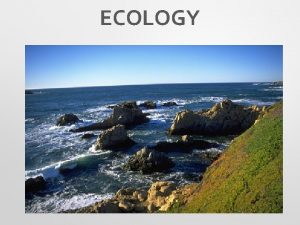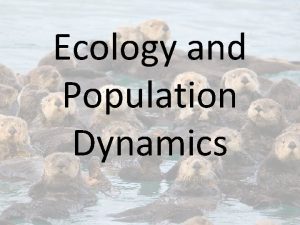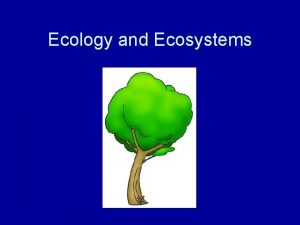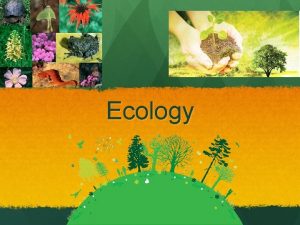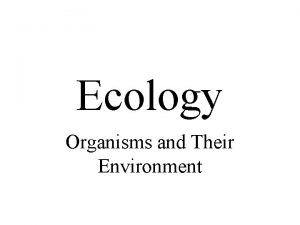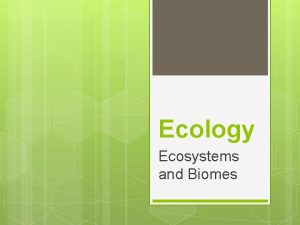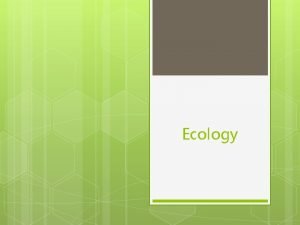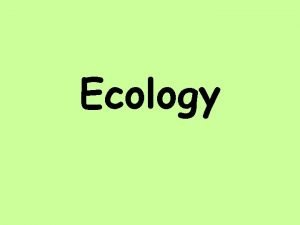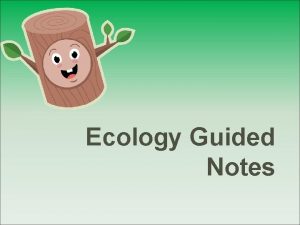Unit 10 Ecology The living and non living

























- Slides: 25

Unit 10: Ecology The living and non living environment Ecology is the study of Ecosystems. Studying the interactions and interdependence of biotic and abiotic factors

A. Levels of Organization SMALL & NUMEROUS atom molecule organelle cell (start of life) tissue organ system organism ____________ _____ (Earth) LARGE & FEW

All the red eye bull frogs in the All the red eye pond 2. ______ – groups of bull frogs, the _____ living in the same area turtles, plants, heron, flies, 3. _______ – interaction and All theand redall eye ants, interdependence of _____ and ____ bull livingfrogs, in thethe factors in a specific area turtles, pond plants, _______ = ____ heron, flies, parts of the environment ants, and all ______ = all the _____ living in the organisms in an environment pond plus all the non-living 4. ______ – group of _____ with the same _______ and similar dominant _______parts of the pond 5. _____ = area from high in the atmosphere to deep in the oceans that supports life 1. _____ – members of the ______ living in the same area


B. Stability in the Ecosystem 1. __________ energy needs to be incorporated into the ecosystem 2. ___________ reuse and recycle materials between organisms and environment 3. ______ – non-living material in the ecosystem a) b) c) d) e) f) Abiotic factors often act as _______, determining how many organisms can survive in the ecosystem.

4. ________ – living material in the ecosystem a) _____ – organisms that can capture energy to make their own food from inorganic compounds _______! Autotrophs = ________ CO 2 + H 2 O + Light C 6 H 12 O 6 + O 2

b) _______ – eat preformed organic compounds Heterotrophs = ________

1) ______ – feed exclusively on plants

2) _______ – feed on animals

3) ________ – feed on both plant and animal matter

4) ________ – feed on dead animals

5) _____ / ______ – feed on decaying matter Detritivore = _________

c) ________ the ways in which organisms in the ecosystem _____ 1) _____ (+, +) – both organisms benefit

2) ________ (+, 0) – one organism benefits from the relationship the other organisms is neither helped nor harmed in the relationship

3. _____ (+, -) – one organism benefits (parasite) the other organism is harmed (host)

4) ____________ - one organism feeds on the other - It may seem that one organism is harmed but it actually helps the species by removing _______ from the population Stops _______

d) _________ - role of the organism in the ecosystem - not just the organism’s feeding relationships but also space, food, habitat, and other conditions it needs to survive and reproduce e) _______ - organisms compete for food, shelter, space, mates - determines which organisms survive evolution f) __________ - variety of life in an ecosystem - more biodiversity the more niches filled more stable ecosystem

C. _______ in the Ecosystem - For an ecosystem to be self-sustaining it needs a _______ flow of energy - Life activities that organisms must perform to stay alive require an __________ - Producers convert the ______ into the __________ in the bonds of __________ - Energy flows in _____ from the source to producers to consumers

1. Food Chains - simple representation of the ______ through organisms in the ecosystem - Arrow shows the direction of energy flow - The arrow points to the organism doing the _____

2. Food Webs - many food chains put together – more accurate representation of the ecosystem - Energy has __________ to flow through *Each step in the food chain / web represents trophic levels *At every level decomposers work to recycle energy and materials

3. Energy Pyramid - represents the relative amounts of energy in each trophic level - 10% Rule – no more than ______________ to the next level - At each successive energy level there is _____ energy - The less energy the ______ (amount of living matter) - What happens if there are more organisms and more biomass on a top level as compared to a level below it?

D. Material Cycles - Materials and matter must be recycled in the ecosystem - Materials must flow between biotic and abiotic systems - Matter is not used up – it is only transformed 1) Water Cycle a) Water moves between the ocean, atmosphere, and land b) ______________, and __________ c) Contamination

2) Carbon – Oxygen – Hydrogen Cycle a) Carbon the key ingredient in all living organisms b) transformed by the processes of _____________, and _________ 1. What process transforms low energy carbon compounds to high energy carbon compounds? 2. What can happen to the carbon compounds in organisms that die and decay in the absence of O 2? 3. What process releases CO 2 to the atmosphere? 4. What are the two major reserves of CO 2 on Earth? 5. How do plants and animals help maintain a balance of CO 2 in the atmosphere? 6. Atmospheric CO 2 produces the “green-house effect” by trapping heat near the Earth’s surface. What human activities increase the amount of CO 2?

3) Nitrogen Cycle a) Organisms need nitrogen for amino acids build proteins b) Nitrogen Gas (N 2) 78% of atmosphere, Ammonia (NH 3), Nitrates (NO 3 -), Nitrites (NO 2 -) found in wastes and decay c) Nitrogen Fixation bacteria on legumes N 2 NH 3 NO 2 - NO 3 d) Denitritfying Bacteria NO 3 - N 2 1. What percent of the Earth’s atmosphere is composed of nitrogen gas? 2. How do plants obtain the nitrogen they need? 3. How do animals obtain the nitrogen they need? 4. What is the role of decomposers in the nitrogen cycle? 5. How is nitrogen returned to the atmosphere? 6. What would happen to the ecosystem if there was a decrease in decomposition?

 Venn diagram living and non living
Venn diagram living and non living Is a moss living or nonliving
Is a moss living or nonliving Living non living dead
Living non living dead What is the smallest living unit of life
What is the smallest living unit of life Les promesses de dieu ne failliront jamais
Les promesses de dieu ne failliront jamais Cycle of carbon
Cycle of carbon Unit 7 ecology answer key
Unit 7 ecology answer key Unit 5 ecology
Unit 5 ecology Unit 10 ecology
Unit 10 ecology Ecology unit review
Ecology unit review Ecology unit review
Ecology unit review Unit 10, unit 10 review tests, unit 10 general test
Unit 10, unit 10 review tests, unit 10 general test Hát kết hợp bộ gõ cơ thể
Hát kết hợp bộ gõ cơ thể Ng-html
Ng-html Bổ thể
Bổ thể Tỉ lệ cơ thể trẻ em
Tỉ lệ cơ thể trẻ em Voi kéo gỗ như thế nào
Voi kéo gỗ như thế nào Chụp phim tư thế worms-breton
Chụp phim tư thế worms-breton Hát lên người ơi
Hát lên người ơi Các môn thể thao bắt đầu bằng từ đua
Các môn thể thao bắt đầu bằng từ đua Thế nào là hệ số cao nhất
Thế nào là hệ số cao nhất Các châu lục và đại dương trên thế giới
Các châu lục và đại dương trên thế giới Công của trọng lực
Công của trọng lực Trời xanh đây là của chúng ta thể thơ
Trời xanh đây là của chúng ta thể thơ Mật thư anh em như thể tay chân
Mật thư anh em như thể tay chân 101012 bằng
101012 bằng





